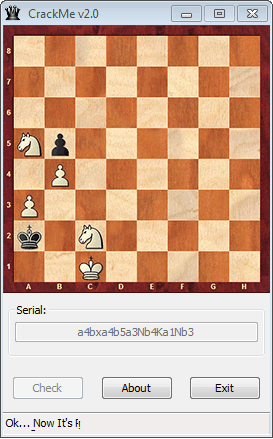Crackmes.de – CrackMe v2.0 by Greedy_Fly
- April 22, 2015
- reverse engineering
- crackmes
- no comments
The crackme CrackMe v2.0 by Greedy_Fly has been published April 22, 2015. It is rated at 2 - Needs a little brain (or luck). The crackme is written in Assembler and runs on Windows. The description reads:
Hi, All…Test Your Skills… ))))
Solution: Valid Serial and solution.txt //Don’t post your solution(Serial) on the board! Have Fun! Greedy_Fly
The crackme greets us with the following user interface:

The chess board looks like a regular “White to move first and checkmate Black”-problem. The serial is probably the solution to the problem. But before trying to solve the chess problem, let’s look at the disassembly first to see if we can find additional hints.
Serial Length
The following lines read the serial, call a subroutine that I named length_function with the length of the serial as the argument, compare the result to 148224 and jump to fail if the values don’t match:
.text:004012E5 push 68h ; nIDDlgItem
.text:004012E7 push [ebp+hWnd] ; hDlg
.text:004012EA call GetDlgItem
.text:004012EF mov dword ptr hwnd, eax
.text:004012F4 lea eax, input ; "serial"
.text:004012FA push eax ; lParam
.text:004012FB push 20h ; wParam
.text:004012FD push 0Dh ; Msg
.text:004012FF push dword ptr hwnd ; hWnd
.text:00401305 call SendMessageA
.text:0040130A push eax
.text:0040130B xchg eax, ebx
.text:0040130C call length_function
.text:00401311 cmp esi, 148224
.text:00401317 jz short valid_length
The routine length_function looks like that:
.text:0040148E length_function proc near
.text:0040148E inc ebx
.text:0040148F shl ebx, 4 ; times 16
.text:00401492 mov esi, 64
.text:00401497 lea edi, [ebx+esi] ; 16*(ebx+1)+64
.text:0040149A imul ebx, edi, 386 ; *386
.text:004014A0 xor esi, esi
.text:004014A2 xchg esi, ebx
.text:004014A4 retn
.text:004014A4 length_function endp
It calculates the following value (where l is the length of the serial):
$$ (16\cdot(l+1) +64)\cdot 386 $$
So we need to have:
$$ \begin{align} (16\cdot(l+1) +64)\cdot 386 &= 148224 \\ (16\cdot(l+1) +64) &= 384 \\ 16l + 80 &= 384 \\ l &= 19 \end{align} $$
Conclusion: The length of the serial needs to be 19 characters.
Hash and Check
If the length of the serial is 19 characters, we get to these instructions:
.text:0040131B valid_length:
.text:0040131B call md5open
.text:00401320 pop ecx
.text:00401321 push ecx
.text:00401322 push offset input ; "serial"
.text:00401327 call make_copy
.text:0040132C call hash
.text:00401331 push offset hex_hash ; "0B17E4358A309CC122E8856AD0FCACEC"
.text:00401336 push 10h
.text:00401338 push eax
.text:00401339 call to_hex
.text:0040133E lea esi, hex_hash ; "0B17E4358A309CC122E8856AD0FCACEC"
.text:00401344 lea edi, a7e9c7f1a62b7b9 ; "7E9C7F1A62B7B93F34A6A6C16BCAA840"
.text:0040134A mov ecx, 20h
.text:0040134F cld
.text:00401350 repe cmpsb
.text:00401352 jnz short fail
The first subroutine — I named it md5open — is:
.text:00402240 md5open proc near
.text:00402240 push edi
.text:00402241 xor eax, eax
.text:00402243 mov offset2, eax
.text:00402248 xor eax, eax
.text:0040224A mov offset, eax
.text:0040224F mov edi, offset input_copy
.text:00402254 mov ecx, 10h
.text:00402259 rep stosd
.text:0040225B mov eax, offset md5
.text:00402260 mov dword ptr [eax], 67452301h
.text:00402266 mov dword ptr [eax+4], 0EFCDAB89h
.text:0040226D mov dword ptr [eax+8], 98BADCFEh
.text:00402274 mov dword ptr [eax+0Ch], 10325476h
.text:0040227B pop edi
.text:0040227C retn
.text:0040227C md5open endp
The last four constants should look familiar: those are the 32bits used as the starting point of the MD5 calculation. Sure enough, eventually the crackme will call the following routine:
.text:00401830 md5_0 proc near
.text:00401830
.text:00401830 var_30= dword ptr -30h
.text:00401830 var_2C= dword ptr -2Ch
.text:00401830 var_28= dword ptr -28h
.text:00401830 var_24= dword ptr -24h
.text:00401830 anonymous_0= qword ptr -20h
.text:00401830
.text:00401830 pusha
.text:00401831 mov esi, offset md5
.text:00401836 mov ebp, offset input_copy
.text:0040183B mov eax, [esi]
.text:0040183D mov ebx, [esi+4]
.text:00401840 mov ecx, [esi+8]
.text:00401843 mov edx, [esi+0Ch]
.text:00401846 mov edi, ebx
.text:00401848 xor edi, ecx
.text:0040184A xor edi, edx
.text:0040184C add eax, [ebp+0]
.text:0040184F add eax, edi
.text:00401851 rol eax, 0Bh
.text:00401854 mov edi, eax
.text:00401856 xor edi, ebx
.text:00401858 xor edi, ecx
.text:0040185A add edx, [ebp+4]
.text:0040185D add edx, edi
.text:0040185F rol edx, 0Eh
.text:00401862 mov edi, edx
.text:00401864 xor edi, eax
.text:00401866 xor edi, ebx
.text:00401868 add ecx, [ebp+8]
.text:0040186B add ecx, edi
.text:0040186D rol ecx, 0Fh
.text:00401870 mov edi, ecx
.text:00401872 xor edi, edx
...
This is the start of the MD5 hashing of the 64 bit value in input_copy. The value of input_copy consists of the entered serial followed by the hardcoded byte 0x80, and the result of 19 times 8, i.e., 0x98, at the eighth last byte:
.data:00404150 input_copy db 61h, 34h, 61h, 34h, 62h, 35h, 61h, 33h
.data:00404150 db 4Eh, 62h, 34h, 2Bh, 4Bh, 61h, 31h, 4Eh
.data:00404150 db 62h, 33h, 23h, 80h, 0, 0, 0, 0
.data:00404150 db 0, 0, 0, 0, 0, 0, 0, 0
.data:00404150 db 0, 0, 0, 0, 0, 0, 0, 0
.data:00404150 db 0, 0, 0, 0, 0, 0, 0, 0
.data:00404150 db 0, 0, 0, 0, 0, 0, 0, 0
.data:00404150 db 98h, 0, 0, 0, 0, 0, 0, 0
After the MD5 hashing seems to follow another hash, maybe SHA. The resulting hash is converted to a hex string by the call at offset 0x401339, and the result is compared to the hardcoded string “7E9C7F1A62B7B93F34A6A6C16BCAA840” (offset 0x401344).
There is no way we can reverse the hash result or even brute-force the 19 character serial. So we really need to solve the chess problem. Fortunately, it is a very easy one. Here is the unique, shortest sequence of moves to get to a checkmate:
- a4
- bxa4
- b5
- a3
- Nb4+
- Ka1
- Nb3#
All that’s left is to convert those move into a 19 character string. Since the above moves take 21 characters, you need to lose the check (+) and checkmate (#) indicators:
a4bxa4b5a3Nb4Ka1Nb3
Entering this string give the goodboy messages:

